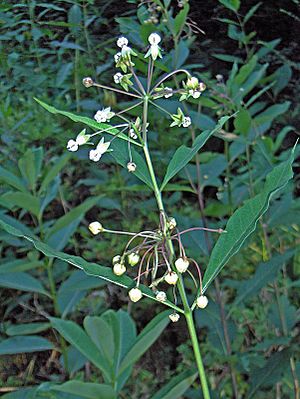Poke milkweed facts for kids
Quick facts for kids Poke milkweed |
|
|---|---|
 |
|
| Scientific classification | |
| Kingdom: | |
| (unranked): | |
| (unranked): | |
| (unranked): | |
| Order: | |
| Family: | |
| Subfamily: | |
| Genus: | |
| Binomial name | |
| Asclepias exaltata L.
|
|
The poke milkweed, also known as tall milkweed (its scientific name is Asclepias exaltata), is a special kind of milkweed plant. It belongs to a group of plants called the Asclepiadoideae subfamily. This plant is known for its tall stems and unique flowers.
Contents
About Poke Milkweed
Poke milkweed is a fascinating plant that grows in the eastern parts of North America. It's a type of flowering plant that adds beauty to woodlands. This plant was first described in 1753 by a famous scientist named Carl Linnaeus.
Where Poke Milkweed Grows
You can find poke milkweed in moist woodland areas. It loves places where the soil is damp and rich. It can grow well in spots that get lots of sunshine or in areas that are partly shaded. This plant is quite adaptable to its environment.
What Poke Milkweed Looks Like
Poke milkweed is a tall plant, usually growing between 0.6 to 1.5 meters (about 2 to 5 feet) high. Its flowers are a mix of green and white, which makes them stand out. These unique flowers bloom from late spring into early summer.
Life Cycle of Poke Milkweed
Like other milkweeds, the poke milkweed plays an important role in nature. Its flowers provide nectar for many insects, including butterflies and bees. After the flowers bloom, the plant produces seed pods. These pods eventually open up to release seeds that have fluffy white hairs, allowing them to float away on the wind and grow new plants.

